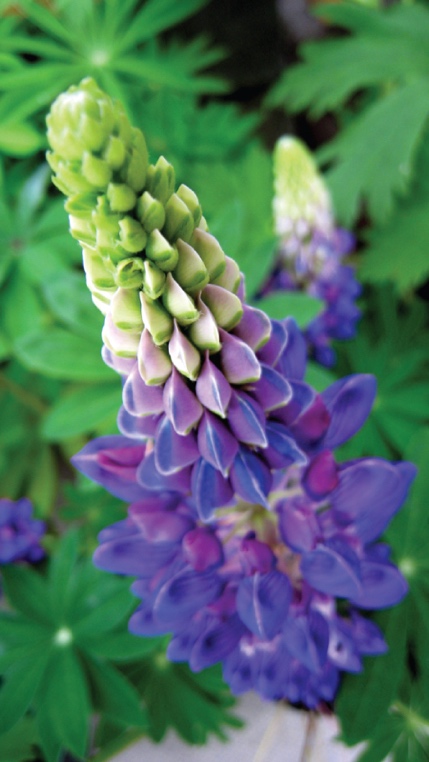Skill Practice: Understanding Text Organization
As a reader, you need to be able to figure out how a text is organized. First, you can look for visual clues, like titles and headings. Then, you can skim the text to try to understand its organization and purpose. A text might follow one of these structures or it could be a combination of them:
- chronological description
- compare-contrast
- definition
- process
- problem-solution
- cause-effect
Graphic Organizers
Each of these text organizations can be visualized in slightly different ways. A text that follows the chronological description structure might be best represented by a time line.

A compare-contrast text might follow the organization in the graphic organizer below.

Practice
With a partner, choose one of the other text organizations and draw a graphic organizer that might best represent it.
Signal Words
Another helpful strategy for identifying the text organization is to look for signal words. As you quickly preview the text, you might notice signal words that hint at the text organization. These might include: as a result, likewise, although, defined as, to consist of, threaten, response, etc.
Directions
Make a list of text organization signal words for each style.
|
cause/effect |
compare-contrast |
definition |
problem-solution |
|
as a result |
although |
defined as |
response |
|
|
|
|
|
|
|
|
|
|
|
|
|
|
|
Pre-Reading
Pre-Reading Activity
Discuss the following questions with a partner.
- According to Figure 3 below, what are the biological levels of organization that ecologists study?
- What is the connection between these levels: organism, population, community, and ecosystem?

The words in bold in the chart are from the following reading. Complete the chart with the different forms of each word.
|
NOUN |
VERB |
ADJECTIVE |
ADVERB |
|
|
endangered |
____ |
|
|
ecology ecologist |
____ |
|
|
|
mutualism |
____ |
|
Reading 2: Levels of Ecological Study [1]
When a discipline such as biology is studied, it is often helpful to subdivide it into smaller, related areas. For instance, cell biologists interested in cell signaling need to understand the chemistry of the signal molecules (which are usually proteins) as well as the result of cell signaling. Ecologists interested in the factors that influence the survival of an endangered species might use mathematical models to predict how current conservation efforts affect endangered organisms. They might be then be called conservation biologists. To produce a sound set of management options, a conservation biologist needs to collect accurate data, including current population size, factors affecting reproduction (like physiology and behavior), habitat requirements (such as plants and soils), and potential human influences on the endangered population and its habitat (which might be derived through studies in sociology and urban ecology). Within the discipline of ecology, researchers work at four specific levels, sometimes discretely and sometimes with overlap: organism, population, community, and ecosystem (Figure 3).
Organismal Ecology
Researchers studying ecology at the organismal level are interested in the adaptations that enable individuals to live in specific habitats. These adaptations can change the shape, physical form, and behavior of organisms. For instance, the Karner blue butterfly (Lycaeides melissa samuelis) (Figure 4) is considered a specialist because the females lay eggs on wild lupine plant. This means that the Karner blue butterfly is highly dependent on the presence of wild lupine plants for its continued survival.

After hatching, the larval caterpillars emerge and spend four to six weeks feeding solely on wild lupine (Figure 5). The caterpillars pupate (undergo metamorphosis) and emerge as butterflies after about four weeks. The adult butterflies feed on the nectar of flowers of wild lupine and other plant species. A researcher interested in studying Karner blue butterflies at the organismal level might ask questions about egg laying and about the butterflies’ preferred temperature (a physiological question) or the behavior of the caterpillars when they are at different larval stages (a behavioral question).

Population Ecology
A population is a group of interbreeding organisms that are members of the same species living in the same area at the same time. (Organisms that are all members of the same species are called conspecifics.) A population is identified, in part, by where it lives, and its area of population may have natural or artificial boundaries: natural boundaries might be rivers, mountains, or deserts, while examples of artificial boundaries include mowed grass, manmade structures, or roads. The study of population ecology focuses on the number of individuals in an area and how and why population size changes over time. Population ecologists are particularly interested in counting the Karner blue butterfly, for example, because it is classified as federally endangered. However, the distribution and density of this species is highly influenced by the distribution and abundance of wild lupine. Researchers might ask questions about the factors leading to the decline of wild lupine and how these affect Karner blue butterflies. For example, ecologists know that wild lupine thrives in open areas where trees and shrubs are largely absent. In natural settings, intermittent wildfires regularly remove trees and shrubs, helping to maintain the open areas that wild lupine requires. Mathematical models can be used to understand how wildfire suppression by humans has led to the decline of this important plant for the Karner blue butterfly.
Community Ecology
A biological community consists of the different species within an area, typically a three-dimensional space, and the interactions within and among these species. Community ecologists are interested in the processes driving these interactions and their consequences. Questions about conspecific interactions often focus on competition among members of the same species for a limited resource. Ecologists also study interactions among various species; members of different species are called heterospecifics. Examples of heterospecific interactions include predation, parasitism, herbivory, competition, and pollination. These interactions can have regulating effects on population sizes and can impact ecological and evolutionary processes affecting diversity.
For example, Karner blue butterfly larvae form mutualistic relationships with ants. Mutualism is a form of a long-term relationship that has coevolved between two species and from which each species benefits. For mutualism to exist between individual organisms, each species must receive some benefit from the other as a consequence of the relationship. Researchers have shown that there is an increase in the probability of survival when Karner blue butterfly larvae (caterpillars) are tended by ants. This might be because the larvae spend less time in each life stage when tended by ants, which provides an advantage for the larvae. Meanwhile, the Karner blue butterfly larvae secrete a carbohydrate-rich substance that is an important energy source for the ants. Both the Karner blue larvae and the ants benefit from their interaction.
Ecosystem Ecology
Ecosystem ecology is an extension of organismal, population, and community ecology. The ecosystem is composed of all the biotic components (living things) in an area along with the abiotic components (non-living things) of that area. Some of the abiotic components include air, water, and soil. Ecosystem biologists ask questions about how nutrients and energy are stored and how they move among organisms and the surrounding atmosphere, soil, and water.
The Karner blue butterflies and the wild lupine live in an oak-pine barren habitat. This habitat is characterized by natural disturbance and nutrient-poor soils that are low in nitrogen. The availability of nutrients is an important factor in the distribution of the plants that live in this habitat. Researchers interested in ecosystem ecology could ask questions about the importance of limited resources and the movement of resources, such as nutrients, though the biotic and abiotic portions of the ecosystem.
Reading Comprehension
Choose the best answer to the following questions.
Which diagram best shows Reading 2’s text organization?
|
a.
|
b.
|
|
c.
|
d.
|
Complete the summary of “Levels of Ecological Study” using keywords from the reading.
Ecology is the study of the interactions of living things with their environment. Ecologists ask questions that comprise four levels of general biological organization—organismal, (2) _______________________, community, and ecosystem. At the organismal level, ecologists study individual organisms and how they interact with their environments. At the population and community levels, ecologists explore, respectively, how a population of organisms changes over time and the ways in which that population interacts with other species in the community. Ecologists studying an (3) _______________________, examine the living species (the biotic components) of the ecosystem as well as the nonliving portions (the (4) ___________________ components), such as air, water, and soil, of the environment.
Match the ecologists with the work they might do.
|
5. ______ Organismal ecologists might… |
ask about an organisms’ natural predators. |
|
6. ______ Population ecologists might… |
b) research the physical requirements of an organism. |
|
7. ______ Community ecologists might… |
c) investigate the population size and distribution of organisms. |
|
8. ______ Ecosystem ecologists might… |
d) study the water and soil that an organism lives in. |
Answer the questions in your own words.
- What aspects of the Karner blue butterfly do organismal ecologists study?
- What is the difference between conspecifics and heterospecifics?
- How do ants help the Karner blue butterfly? What is that an example of?
- Which type of ecology do you find the most interesting? Why?
Vocabulary Practice
Look at the sentences from “Reading 2.” Find the meaning of the words in bold.
- “A population is identified, in part, by where it lives, and its area of population may have natural or artificial boundaries: natural boundaries might be rivers, mountains, or deserts, while examples of artificial boundaries include mowed grass, manmade structures, or roads.” .” What does boundary mean?
- “Some of the abiotic components include air, water, and soil.” What does component mean?
- “potential human influences on the endangered population and its habitat… might be derived through studies in sociology and urban ecology” What does derived mean?
- “When a discipline such as biology is studied, it is often helpful to subdivide it into smaller, related areas.” What does discipline mean?
- “Within the discipline of ecology, researchers work at four specific levels, sometimes discretely and sometimes with overlap: organism, population, community, and ecosystem” What does discretely mean? What does overlap mean?
- “Ecosystem biologists ask questions about how nutrients and energy are stored and how they move among organisms and the surrounding atmosphere, soil, and water.” What does nutrient mean?
- “Researchers interested in ecosystem ecology could ask questions about the importance of limited resources and the movement of resources, such as nutrients, though the biotic and abiotic portions of the ecosystem.” What does portion mean?
- “These interactions can have regulating effects on population sizes” What does regulate mean?
- “the larval caterpillars emerge and spend four to six weeks feeding solely on wild” flowers. What does solely mean?
Bonus: Choose two of the quotes above to paraphrase, stating the information in your own words.
Reading Discussion
Discuss these questions with your group.
- Ecologists often collaborate with other researchers interested in ecological questions. What might they collaborate on (and at what level of ecology)?
- Conversely, what levels of ecology might be more difficult for collaboration with other researchers?
- Population is an important unit in ecology as well as other biological sciences. How is a population defined in the reading, and how is that different from your understanding of population?
- Download the original, un-adapted version for free at https://cnx.org/contents/jVCgr5SL@15.47:Mt6xRakD@10/44-1-The-Scope-of-Ecology ↵




